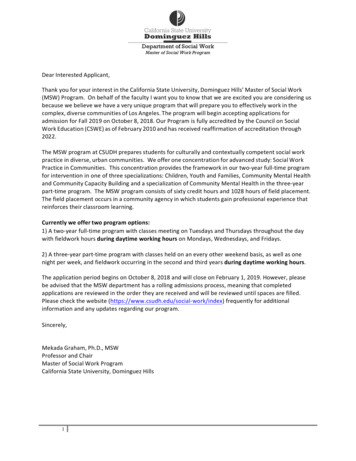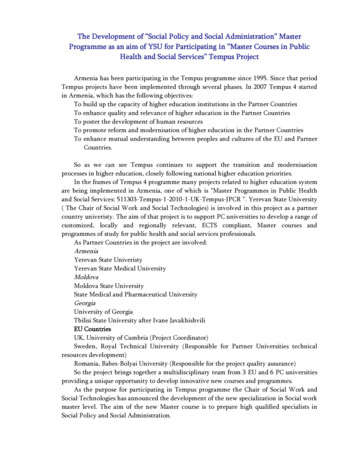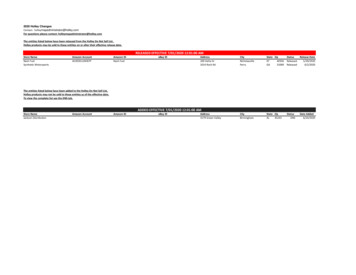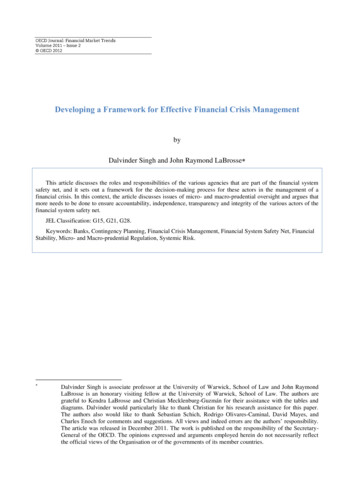
Transcription
3 Principles for Effective SocialWork Case ManagementWhite Paper / August 2016(702) 605.6870 / support@clarityhs.com / www.clarityhumanservices.com / www.bitfocus.com
EXECUTIVESUMMARYAs an individual working in social work casemanagement, you strive to have a positiveimpact on the community around you. Youserve as a catalyst to better lifestyles for eachof your clients. However, your job isn’t easy.You oversee multiple elements of a client’swellness. As such, you are responsible for awide array of tasks during the time betweeninitial assessment and final discharge. At times,client relationship can become secondary tothe frenzy of service coordination,documentation, communication amongproviders, burdensome technology, and otheraspects of such an unpredictable field. Thiswide spectrum of responsibility can make itdifficult to maintain focus, which can hinder youfrom effectively facilitating transformation inyour clients’ lives.This is why it's helpful to understand threebasic principles that will enable you to be moreeffective at social work case management.These principles are tried and true, based onthe experiences of human servicesprofessionals using Clarity Human Servicescase management software, as well as theexpertise of Clarity Human Services staff.!2Taking practical steps to apply theseprinciples to your day-to-day work willhelp you stay on track, and see betterresults in your job.The purpose of this white paper is topresent three principles for effectivesocial work case management:1. Evidence-based practice2. Trusting relationships3. Client empowermentFor each principle, we’ll look at thephilosophy behind it, some practicalsteps you can implement, and someexamples and resources you canreview.
TABLE OF CONTENTSPrinciple #1: Trusting Relationships4Principle #2: Evidence-Based Practice7Principle #3: Client Empowerment10Conclusion13References14
PRINCIPLE #1TRUSTINGRELATIONSHIPSThe therapeutic relationship between practitioner and client plays anintegral role in case management.[1] Developing this kind of relationshipwith your client enables you to better engage them and develop theappropriate interventions for them.A large part of this principle is providing a safe environment for your clients to share their story,problems, and feelings. Clients have indicated that the following four personality characteristics aremost important to them in a social worker: Understanding Empathic Pleasant Ability to put one at ease[2]When you embody these characteristics, you communicate that you are genuinely interested inyour client and that you are a safe person. Another key part of being a safe person is maintainingconfidentiality at all times. It’s important that your client knows you are someone they can trust toprotect their story.Practical StepsCONVEY EMPATHYStudies have shown that patients with anempathetic therapist tend to progress more intreatment and experience a higher probability ofeventual improvement.[3][4]“[In your ability to convey empathy], youare a confident companion to the personin his/her inner world. By pointing to thepossible meanings in the flow of his/herexperiencing, you help the person tofocus on this useful type of referent, toexperience the meanings more fully, andto move forward in the experiencing.”[5]— Carl R. Rogers, PhD4!
Keep in mind that empathy is different from sympathy. Sympathy ishaving a concern for a client’s well-being but not necessarily having adeeper understanding of the client’s thoughts and feelings. On the otherhand, empathy refers to accepting and understanding the client’s feelings,helping you become better equipped to help the client help themselves.[6]Some practical ways to convey empathy, include: Suspending your own judgments and critiques Using reflection to clarify what the client is saying Keying in to shared human values[7]SHOW CONFIDENCE IN YOUR SKILLSIt can be scary, awkward, and challenging to build a relationship with a client who may be goingthrough experiences you can’t relate to. And sometimes, you might even have clients who expressdoubt in your ability to help them. Regardless of extraneous factors, always maintain yourconfidence.Sharon Lacay shares this story in The New Social Worker:“ Two sessions in, my fears were confirmed when one of the women remarked that I lookedyoung and that I may not be able to understand where she and the others were coming from.She continued and voiced her doubts that I may not be able to appreciate their seasonedwisdom about life. In response, I paused for a moment and gathered my confidence. I said,“You are right. I’m not an expert on life, or yours. One of the great things about being a part ofthis group is that we can learn from each other. I’d love if you told me more about yourself,what you think makes you strong, and what you hope to gain from our work together.”“This took her by surprise, and I felt a sigh of relief when she smiled and noticeably let herguard down. By validating her reluctance and showing that I wasn’t there to tell her how tolive her life or how to heal, she saw me as an ally.”[3]FOCUS ON THE CLIENTThis is a broad topic, but we want to discuss here the importance of balancing active listening withintake, assessment, and documenting other case notes. Gathering the necessary information tohelp your client is important, but so is making sure your client feels heard so they continue to shareinformation with you. In addition to practicing the tips mentioned for conveying empathy, be sureto lean forward, make eye contact and nod your head when appropriate.5!
One of the best ways to balance active listening with data collection is to use a client managementsoftware that is easy to use. When you have a client management software that makes it easy toenter data and take notes, you no longer have to focus on the hassles of technology. Instead, youcan focus on your client, confident that you gathering the required information while still givingyour client full attention.Examples and ResourcesBelow are some examples and resources to help you look further into this principle:6! Empathic: An Unappreciated Way of Being Breaking Boundaries with Empathy: How the Therapeutic Alliance Can Defy Client/Worker Differences Four Techniques for Active Listening How to Conduct a Client Interview
PRINCIPLE #2EVIDENCE-BASED PRACTICEAs evidence-based practice (EBP) is increasingly emphasized in socialwork, it’s an important principle for social workers and case managers toremember and apply.EBP is a process practitioners use to guide and inform the delivery of treatments and services,integrating the following four components: Current client needs, situation, and environment Best available research evidence Client values and preferences Clinician’s judgment and expertiseEvidence-based practice requires that the practitioner, researcher, and client work together toidentify and determine what works, and for whom and in which particular situations.[8] The EBPapproach ensures that the development and implementation of treatment and services producethe most effective outcomes possible.There is much that can be said about evidence-based practice, but one important aspect worthnoting is that each of these components is equally weighted. Many practitioners and other7/
professionals have mistakenly thought that EBP means evaluating best available evidence, focusingon academic research alone. However, research evidence is only one of four parts in the process;the other three are critical to doing EBP correctly.[9]Practical StepsANALYZE & ADJUSTEven though the research supports a particulartreatment, you may need to take a differentroute if you’re not seeing positive change inyour client’s life.Bonnie Spring, PhD, says:“Suppose you start giving the treatment thathad the very best research support. Threemonths into the treatment, the client isdeteriorating, but you’re continuing to give thesame treatment. I’d say that you’re no longerdoing evidence-based practice. Part of theevidence-based practice process is that youhave to analyze and adjust. You need tomeasure how you’re doing because if you’reimplementing a best practice but the client isdeteriorating, you’ve got to change course.Just doing what the overall body of researchsays is only where you start. From there on, youmake choices based on what your own client’sdata show is working.”[10]COLLECT & EVALUATE QUALITY DATAIn order to use the evidence-based practicemodel, you must take the time to collect andevaluate precise data. In doing so, you are ableto clearly see what works and what doesn’twork, allowing you to confidently incorporatethis data into the EBP process.One way to ensure quality data collection andevaluation is the proper utilization of casemanagement software. When you have a client8/management software that complies withindustry data standards, facilitates streamlinedintake and assessment, and allows for seamlessgeneration of reports, you can rest assured thatyou are gathering the information necessary tobest inform your practice.USE GIS TO BETTER UNDERSTANDENVIRONMENTGIS (geographic or geospatial informationsystems) is a significant but often overlookedtool that can be used to foster better serviceplanning and delivery to people in need.[11]Social and environmental factors vary for eachcommunity, making it important to study thespecific neighborhood in which your clientlives.[12] Geographical location can help youunderstand the barriers your client may befacing, such as health problems present in theneighborhood, lack of quality public educationand/or affordable housing, high crime rates,etc.There are several different ways to access datafrom geographic information systems, or tocollect the data yourself. One option is to use acase management software that has a built-inGIS tool, combining map data visualization withpowerful analytics. Using an integrated systemlike this makes it easy to conduct data entry,reporting and GIS techniques all in a singleinterface. Other options are listed here.
Examples and ResourcesBelow are some examples and resources to help you look further into this principle:9 Evidence-Based Practice Social Work: Evidence-Based Practice Resources Bridging Evidence-Based Practice with Social Work
PRINCIPLE #3CLIENTEMPOWERMENTDating back to the late 19th century, early social work case managers viewedthemselves as benevolent helpers. However, caseworkers today now recognizetheir relationship with clients as a partnership instead.[13]As you recognize the dignity, worth, and rights that belong to each of your clients, youcan instill a sense of self-determination in each of your clients as you guide them. This willempower them to reach higher levels of life satisfaction. This will also leave them with theconfidence to make healthy choices.“The personal empowermentdynamic is similar to a traditionalclinical notion of self-determinationwhereby clients give direction tothe helping process, take chargeand control of their personal lives,get their ‘heads straight,’ learn newways to think about their situations,and adopt new behaviors that givethem more satisfying and rewardingoutcomes. Personal empowermentrecognizes the uniqueness of eachclient.”[14]— Charles D. CowgerWhile you act as the early support system for yourclient, it’s important that you help them build their ownsupport systems and make their own decisions,encouraging the client to reach more effective andsustainable outcomes.Practical StepsHELP THE CLIENT DEFINE AND OWN THEIR STORYThis is part of being empathic when interacting withyour client. The significance of helping the client definetheir situation—clarifying the reasons they have soughtassistance—and helping them evaluate and givemeaning to the factors that affect their situations.[14]But remember that as you listen and seek to understand10
your client’s situation, you must be careful to remember it is their story, notyours.In assessment, the client’s understanding of their own situation—their view of thesituation, the meaning they ascribe to the situation, and their feelings or emotions tiedto the situation—surpass facts found in client data, academic research, and your personalor professional interpretation of the client’s story. In this, it’s important to believe the client.[14]“There is no evidence that people needing social work service tell untruths any more than anyoneelse,” Cowger writes. “ Clients may need help to articulate their problem situations, and ‘caringconfrontation’ by the worker may facilitate that process. However, clients’ understandings of realityare no less real than the social constructions of reality of the professionals assisting them.”[14]The client owns the story, and if they sense that you respect their ownership of their story, they willfeel empowered to more fully share it with you.[14]RECOGNIZE THE CLIENT’S INDIVIDUALITYBecause every client is different, the treatment and services they receive must be tailored to theclient’s specific needs. In one regard, this involves asking the client questions such as: What do you want and expect from assistance? What do you hope to have happen in relation to your current problem situation? What do you believe are your strengths?Asking these questions helps the client consider their own situation and contribute to their owntreatment and services plan.Recognizing the client’s individual needs also involves customizing intake forms, creating goalplans and targeted variables, and streamlining the assessment and prioritization process for eachindividual client. This can be done through a case management software that allows for thesecustomization, measurement, and prioritization capabilities.AVOID BLAME AND BLAMINGFocusing on blame—whether the client blames others, or assumes blame themselves—hinders theprocess of finding a solution to the client’s problem. If the client blames themselves, it onlyencourages low self-esteem. If the client blames others, the client may resolve to helplessness,losing motivation to learn how to address the problem. This is the opposite of clientempowerment.11
It is ineffective to assign blame when most client situations encountered are a combination ofcountless possible events, including physical and/or mental health, social environments, and otherchance happenings.[14] If the assessment turns to blame, redirect the conversation. Remember that“things happen; people are vulnerable to those happenings, and therefore, they seekassistance” (Cowger).[14]Examples and ResourcesBelow are some examples and resources to help you look further into this principle:12 Assessing Client Strengths: Clinical Assessment for Client Empowerment Social Work with Homeless Mothers: A Strength-Based Solution-Focused Model
CONCLUSIONYour job is essential to the well-being of your client and theircommunity. While social work case management involves manydifferent roles to fill and moving parts to coordinate, enteringyour work each day with these three principles in mind canhelp pull those pieces together.As you assess your client, providing a safe environment anddeveloping a relationship built on trust encourages the client to open up and work with you inorder to best understand their situation. Applying the evidence-based practice process ensuresyou’re continually testing and adjusting the treatment and services that work best for your client.Finally, throughout your interactions with your client, empowering them to own their story and setgoals increases the likelihood of bringing about positive, sustainable outcomes in your client’s life.13
REFERENCES[1] NASW[2] TheStandards for Social Work Case Management [PDF]. (2013). National Association of Social Workers.Client-Worker Relationship [PPT]. (n.d.). Minnesota State University Moorhead.[3]Lacay, S. (2013, Summer). Breaking Boundaries With Empathy: How the Therapeutic Alliance Can Defy Client/Worker Differences. Retrieved July 19, 2016, from ice/Breaking Boundaries With Empathy: How the Therapeutic Alliance Can Defy Client-Worker Differences/[4] Norcross,J. C. (Ed.). (2011). Psychotherapy relationships that work: Evidence based responsiveness (2nd ed.). NewYork: Oxford University Press.[5] Rogers,C. R. (1975). Empathetic: An unappreciated way of being. Counseling Psychologist, 5, 2-10.[6]Vasquez, T. (2013, December). How Social Workers Build Relationships with Clients. Retrieved July 19, 2016, /social-work-skills[7] Cohen,E. D. (2015, May 17). How to Be Empathetic. Retrieved July 19, 2016, from istotle-do/201505/how-be-empathetic[8] Evidence-BasedPractice. (2010, June 16). Retrieved July 19, 2016, from based-practice-2.html[9] Drisko,J. W., & Grady, M. D. (2015, September). Evidence-Based Practice in Social Work: A ContemporaryPerspective. Clinical Social Work Journal, 43(3), 274-282. doi:10.1007/s10615-015-0548-z[10] Surface,D. (2009, July/August). Understanding Evidence Based-Practice in Behavioral Health. Retrieved July 19,2016, from html[11] Vernon,R. (2005). Technology Convergence and Social Work: When Case Management Meets GeographicInformation [Abstract]. Advances in Social Work, 6(1). Retrieved July 19, 2016, from ialwork/article/view/82/70.[12] Colonnieves,K. (2016, April 8). Using GIS to Solve 3 Common Problems in Helping the Homeless. Retrieved fromClarity Human Services, gis-homeless-solutions/[13] Herman,C. (2013, January). The Evolving Context of Social Work Case Management: NASW Releases RevisedStandards of Practice. Practice Perspectives, (Winter). Retrieved July 19, 2016, from ctice/Case Management Standards.pdf[14] Cowger,C. D. (1994, May). Assessing Client Strengths: Clinical Assessment for Client Empowerment. Social Work,39(3), 265-266. Retrieved July 19, 2016, from https://www.preventchildabusenj.org/documents/fop admin/9407122511.pdf14
case management software, as well as the expertise of Clarity Human Services staff. !2 Taking practical steps to apply these principles to your day-to-day work will help you stay on track, and see better results in your j








![Fluent Python : [clear, concise, and effective programming]](/img/1/799981060.jpg)


